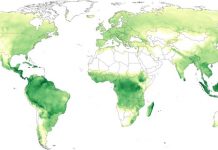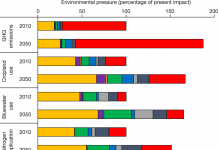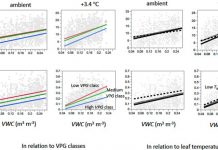【基岩中摆脱岩石束缚后逸出的氮能支持生命】B. Z. Houlton, S. L. Morford, R. A. Dahlgren. Convergent evidence for widespread rock nitrogen sources in Earth’s surface environment. Science, 2018,360:58-62
尽管陆地土壤和植被中的氮素一直被认为基本来自大气,但一项新的研究指出了另一个先前被低估的氮素来源:风化的基岩。由于可得到的氮素多寡决定了植物的生长,这些结果对了解碳循环及全球气候改变具有重要意义。在他们的研究中,Benjamin Houlton等人指出,一般认为,碳素大多经由大气进入地球陆地表面的生态系统,然而地下存在着丰富的氮素,氮素会在岩石风化时被释放出来。为了探索这一途径的氮素释出程度,作者使用了3种不同的方法。在第一个方法中,他们对整个地球的大气、生物圈、水圈和地圈中N交换的研究进行了观察,旨在构建地质时期内氮素的总体进入与逸出情况。在第二个方法中,他们对形形色色的地球化学代用物质(包括化石样本中的有机碳)做了检查,旨在估测有多少碳(及因而有多少N)会随着时间而被释放;他们所得到的数值与第一种方法所得结果吻合良好。在最后的那个方法中,他们用建模来探索氮通量。基于他们的这3个分析,作者提出,岩石风化占了整个陆地氮平衡的6-17%,或每年1012克的氮,这一数量堪比来自大气的氮。(来源:Eurekalert网站)
Abstract
Nitrogen availability is a pivotal control on terrestrial carbon sequestration and global climate change. Historical and contemporary views assume that nitrogen enters Earth’s land-surface ecosystems from the atmosphere. Here we demonstrate that bedrock is a nitrogen source that rivals atmospheric nitrogen inputs across major sectors of the global terrestrial environment. Evidence drawn from the planet’s nitrogen balance, geochemical proxies, and our spatial weathering model reveal that ~19 to 31 teragrams of nitrogen are mobilized from near-surface rocks annually. About 11 to 18 teragrams of this nitrogen are chemically weathered in situ, thereby increasing the unmanaged (preindustrial) terrestrial nitrogen balance from 8 to 26%. These findings provide a global perspective to reconcile Earth’s nitrogen budget, with implications for nutrient-driven controls over the terrestrial carbon sink.

———————————————————————————————————————————————–
【陆生植物扎根于沉积岩】Woodward W. Fischer. Early plants and the rise of mud, Science,2018, 359:994-995
据新的研究报道,地质记录显示,泥岩出现的时间(5亿年前)与植物出现的时间差不多同时。这些结果对了解地球的演变过程(诸如侵蚀)提供了重要的线索,它们甚至可能对远古的海洋化学提供了新的线索。在地质记录中,河谷或三角洲内由流动河流留下的粘土、淤泥、沙、砾沉积物为地球的演变过程绘出了一个时间表。在地质记录中,当陆地于大约5亿年前出现植物之前,泥岩存在的证据被认为是罕见的,但这一观念尚未得到确认。在这项研究中,William McMahon和Neil Davies对已发表的近1200个报告中的沉积物数据以及来自125个原始现场调查的数据进行了分析。他们的结果显示,在地球沉积岩记录的头~30亿年中,泥岩在沉积物中几乎不存在,但它们在古生代中期之后则变得常见或占支配地位。作者指出,泥岩的存在随着时间而稳定增加,它排除了这是一个诸如地壳构造或气候控制等周期性或偶发现象结果的可能性。泥岩稳定性增加加上同期植物的出现强烈提示这两个事件之间存在着某种关系。Woodward Fischer在相关的《视角》中提供了更多的背景材料,他指出:“如果泥岩最初增加的时间是正确的,这表明最早期的植物给地貌留下了深刻的印记。”(来源:Eurekalert网站)
Summary
The geological record of our planet provides evidence for a handful of ways in which life has fundamentally altered processes and environments at Earth’s surface. It was the evolution of photosynthesis nearly 2.5 billion years ago that oxygenated the atmosphere and oceans (1), greatly increasing the spectrum of minerals found in rocks (2). Over the past 250 million years, the production of mineral skeletons by algae in the oceans transformed the way in which sediments accumulate in marine basins (3). On page 1022 of this issue, McMahon and Davies (4) illustrate how plants, too, have left an indelible mark in the geological record, their signature written in mud.
William J. McMahon, Neil S. Davies*. Evolution of alluvial mudrock forced by early land plants,Science,2018,359:1022-1024
Abstract
Mudrocks are a primary archive of Earth’s history from the Archean eon to recent times, and their source-to-sink production and deposition play a central role in long-term ocean chemistry and climate regulation. Using original and published stratigraphic data from all 704 of Earth’s known alluvial formations from the Archean eon (3.5 billion years ago) to the Carboniferous period (0.3 billion years ago), we prove contentions of an upsurge in the proportion of mud retained on land coeval with vegetation evolution. We constrain the onset of the upsurge to the Ordovician-Silurian and show that alluvium deposited after land plant evolution contains a proportion of mudrock that is, on average, 1.4 orders of magnitude greater than the proportion contained in alluvium from the preceding 90% of Earth’s history. We attribute this shift to the ways in which vegetation revolutionized mud production and sediment flux from continental interiors.
————————————————————————————————————————————————
Kathy J. Willis, Elizabeth S. Jeffer, Carolina Tovar1. What makes a terrestrial ecosystem resilient? Science, 2018,359:988-989
Summary
With increasing incidence of extreme climatic events, disease outbreaks, and other environmental perturbations, conservation of terrestrial ecosystems that can retain their structure and function despite environmental shocks has moved rapidly up the international political agenda. International environmental policies and targets such as the Aichi Biodiversity Targets and the Sustainable Development Goals include conserving resilient ecosystems as a key priority.
———————————————————————————————————————————————
John D. Protasiewicz. From rock-stable to reactive phosphorus. Science, 2018, 359:1333
Summary
The main use of phosphate minerals is as fertilizer, but phosphorus is used in herbicides, flame retardants, drugs, battery electrolytes, and other materials. To date, the key feedstock for these materials is elemental phosphorus, particularly white phosphorus (P4). Reduction of phosphate to P4 is energy intensive, and it must be converted into other intermediates, such as PCl3, through reaction with chlorine gas (all of which are highly reactive and toxic). On page 1383 of this issue, Geeson and Cummins (1) report a set of simple transformations that afford a less energy-intensive strategy for converting phosphate into the bis(trichlorosilyl)phosphide anion 1. Anion 1 serves as a P4 surrogate useful for the synthesis of a number of important organophosphorus compounds, including an organophosphorus-based drug.







